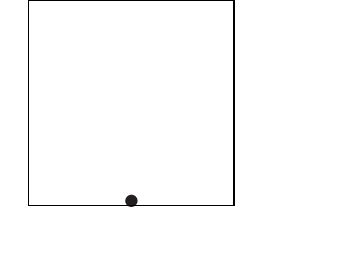Home
Brief CV
Research
Teaching
Outreach
Conferences
Software
Press
LHC and Philosophy

DFG RTG
|
[Up: aximate]
aximate: evolve evolve The default evolution from the start to the end parameters
of an object is linear, i.e.
$value = $start + ($t-$t0)/($t1-$t0)*($end - $start) where $t
evolves uniformly from $t0 to $t1 during the active interval [$t0,$t1] of an object.
However, aximate allows you to modify this evolution by
specifying the function of $t according to which a certain option
should evolve. This is done by providing a second (referenced) hash to the
object. For example, an oblique throw can be represented as:
point({"coordinates" => [[],[]]},
{"coordinates" => ['$t-50','50-2*(50-$t)**2/50']});
|

|
A jumping ball, following the path
x($t) = $x0 + $b $t - 1/2 $g $t2
can be aximated with a do-loop:
sub manual12 {
my($norm,$num,$bound1,$bound2,$i,$g,$x0,$b);
$num = 10;
$bound1 = 0;
$bound2 = 0;
$norm=0;
# make sure that the jumps fill out the full time interval:
foreach $i (1..$num) {
$norm += 1/sqrt(2**$i);
}
# the "gravitational" acceleration:
$g = 1;
$x0 = -98;
for $i (1..$num) {
# the length of the current time interval:
$deltat = 100/$norm/sqrt(2**$i);
$bound2 = $bound1 + $deltat;
# with this choice of $b, it is x($bound1)=x($bound2)=$x0:
$b = $g/2*$deltat;
# defining empty start and end coordinates ensure that the evolution
# is fully determined by the evolve function:
point({"coordinates" => [[],[]],
"interval" => [$bound1,$bound2]},
{"coordinates" => ['0',
$x0.'+'.$b.'*($t-'.$bound1.')-1/2*'.$g.'*($t-'.$bound1.')**2']});
$bound1 = $bound2;
}
}
|

|
A few remarks: let us assume that f($t) is the evolution
function.
- If both the $start and the $end
value of the evolved parameter param is given, aximate adds a linear function
to the evolution such that these points are actually reached:
param($t) = f($t) + $start - f(0) + $t*($end-$start-f(1)+f(0));
i.e. param(0)=$start and param(1)=$end.
Note that this means that even if f($t) = const, the values
will evolve linearly from the $start to the $end.
- If the $end value is missing, it is assumed to be equal to
the $start value, so that the evolution is circular.
- If the $end value is given but empty (i.e. []),
aximate sets $end=f(1), so that
param($t) = f($t) + $start - f(0) + $t*(f(0)-$start);
i.e. param(0)=$start, param(1)=f(1).
- If the $start value is given but empty (i.e. []),
aximate sets $start=f(0), so that
param($t) = f($t) + $t*($end-f(1));
i.e. param(0)=f(0), param(1)=$end.
- If both the $start and the $end value is given
but empty (i.e. []), the evolution
function is
param($t) = f($t)
It is important to note that if you want param to evolve exactly as
determined by the evolution function f($t), you need to define both
the start and end coordinate as empty lists. If you do not define them,
aximate will use the default values which are not empty.
For example,
point({"coordinates" => [[],[]]},
{"coordinates" => ['50*cos(2*pi*$t)','50*sin(2*pi*$t)']});
will move a point in a circle of radius 50 around the origin, while
point({},
{"coordinates" => ['50*cos(2*pi*$t)','50*sin(2*pi*$t)']});
will use the default for the coordinates parameter, which happens
to be [[0,0],[0,0]]. The start and end point of the
movement is thus at (0,0), so that the point will move on a circle of radius
50 around the point (-50,0).
|

|
main
|